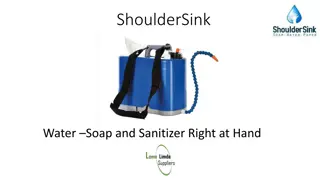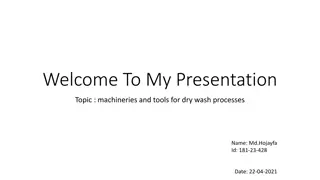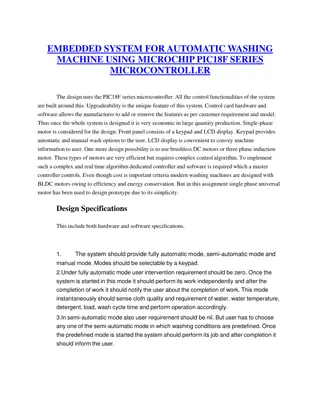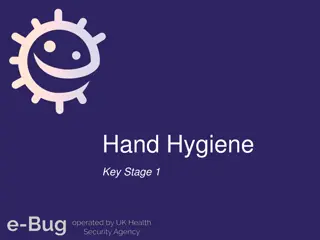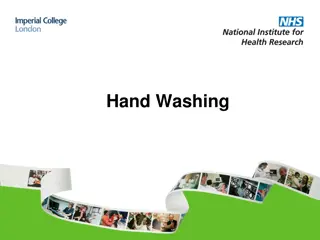Essential Laundry Tips: Washing Instructions, Clothing Preparation & Bleach Safety
Understanding the importance of reading garment labels before laundering, proper clothing preparation tips, knowing which types of clothing to wash in hot, warm, or cold water, precautions for using chlorine bleach, benefits of powdered oxygen bleach, and why chlorine and ammonia should never be mixed due to the release of toxic gases.
Download Presentation

Please find below an Image/Link to download the presentation.
The content on the website is provided AS IS for your information and personal use only. It may not be sold, licensed, or shared on other websites without obtaining consent from the author.If you encounter any issues during the download, it is possible that the publisher has removed the file from their server.
You are allowed to download the files provided on this website for personal or commercial use, subject to the condition that they are used lawfully. All files are the property of their respective owners.
The content on the website is provided AS IS for your information and personal use only. It may not be sold, licensed, or shared on other websites without obtaining consent from the author.
E N D
Presentation Transcript
LAUNDERING By Sindi Mkwanazi
1. Why is it important to read labels in garments before laundering them The labels often include the recommended washing instructions along with the materials the garment is made from Instructions often include : Wash temperature Rinse Temperature Ironing temperature and sometimes the ironing method.
2. What is the proper way to prepare clothes for washing Remove all items from pockets Zip up any zippers Cover any Velcro Tie up any strings to avoid them getting tangled with other clothes. Separate your laundry in like piles White clothing Delicate clothing Dark clothing etc.
3. What types of clothing should be washed in hot, warm and cold? Hot water: white clothing & Really dirty clothing Warm water: whites and delicate clothing Cold water: bright colours, dark colours and delicate knitted clothing
4. What precaution should be used when using chlorine bleach? Bleach is a very powerful chemical. can burn your skin, and it can dissolve cloth. Do not get it on your skin; if you get it on your skin, wash it off right away. If you spill it on your clothing, rinse immediately. If too much bleach is used on cloth, the cloth will disintegrate. Bleach will remove dye, so it must not be used on anything other than white cloth.
4. What are the advantages of powdered oxygen bleach? The greatest advantage offered by powdered oxygen bleach is that it removes stains without the use of toxic chemicals. For some stains, it works even better than chlorine bleach. It brightens fabrics and can be used on carpet. It is non-toxic to humans and animals, and it breaks down into environmentally friendly components when the oxygen is released.
4. Why should chlorine and ammonia never be mixed? Bleach and ammonia should NEVER causes a chemical reaction that releases poisonous gases. NEVER be mixed because doing so The gas released is chlorine gas which was used as a chemical warfare agent during World War I. Chlorine gas is highly toxic. Other gases that can be released include nitrogen trichloride (which can explode in your face), and hydrazine (a component of rocket fuel).
5. What precautions should be taken when using liquid fabric softeners? Liquid fabric softeners leave an invisible residue on the garment which prevents static cling, softens the fabric and betters the smell. It should only be used in the rinse cycle when no soap is in the water. The combination of soap and fabric softener will cause a sticky, visible residue on the clothing
6. What points are to be considered when selecting a washing machine, dryer and iron? Is it an energy efficient appliance? Buying an energy efficient appliance - even if it is more expensive - can save you a lot of money in the long run. How large a load can it take? Another factor to consider is the amount of laundry you intend to do with the appliances. If you are going to do laundry for a family of six, you will need a larger machine than if you are going to do laundry for a family of two. When selecting an iron does it have safety enhancing features. E.g. does it turn itself off when not in use?
6. How should these items be cared for? Wipe down your appliances regularly, and use appliance touch-up paint to repair any chips in the finish. An untreated chip will lead to rust which can destroy your appliance. Do not iron over silkscreen designs, as this will melt the paint on the garment and stick to the iron. This residue is extremely difficult to remove from an iron, and if left there, will transfer to any other garments you use it on.
7. How are woollen and wool like garments laundered? Soak the garment in cold water for about 15 minutes. You can use shampoo instead of detergent, or you can use detergent specially formulated for wool. You can then change the water and soak the garment in clean water for another 15 minutes, or you can put it in a washing machine. If you decide to put it in a washing machine, make sure to select a setting that will not agitate the load. Also, be sure to use cold water.
8. Know how to remove the following stains Blood: Blood: If the blood is fresh, wipe it up with a sponge soaked in cool, salted water. Then rinse with clear water. If the blood is dried, use diluted hydrogen peroxide Chewing gum: Chewing gum: Scrape off as much as possible first. This is easier if you cool the gum down with ice cubes first, as that makes the gum brittle rather than gummy. If the item is washable, apply a little kerosene or dry cleaning fluid and rinse it off. You may have to repeat this several times. Grass: Grass: If the garment is white, you may soak it in a solution of chlorinated bleach, then rinse and launder. Otherwise, apply methylate alcohol (wood alcohol) to the stain, rinse in warm water, and then wash. Grease: Grease: Scrape away as much of the grease as you can. Rub petroleum jelly into the stain, and then wash with a laundry powder or liquid detergent. You can also try a spot removing product.
8. Know how to remove stains. Why must stains be removed before laundering? Why must stains be removed before laundering? == Putting a stained garment in a dryer will set the stain, making it even more difficult to remove. Always remove stains before laundering. https://youtu.be/p8uk--CoKVA https://youtu.be/X9WZ4xoAobg Alternative methods
9. Why is it important to remove garments from a dryer when the cycle is complete? When a garment is still hot from the dryer, hanging it immediately will prevent it from getting wrinkled. If you forget to remove the garments from the dryer the wrinkles will start to set.
10. Know what type of materials should be dried only on the lowest heat setting of a dryer. Some items should not be dried in a dryer at all. Particularly, any item containing foam rubber should not be placed in a dryer except on a no-heat setting, as it can easily burst into flame. Knits and delicates (such as silk and nylon) should only be dried on the lowest heat settings.
Homework Do the laundry at home for 1 week. This includes ironing, hanging the washing on the washing line, putting clothes in the washing machine, putting clothes in the tumble dryer and hand washing clothes. You must also iron your Pathfinder shirt and a picture of you ironing it is needed for evidence.









